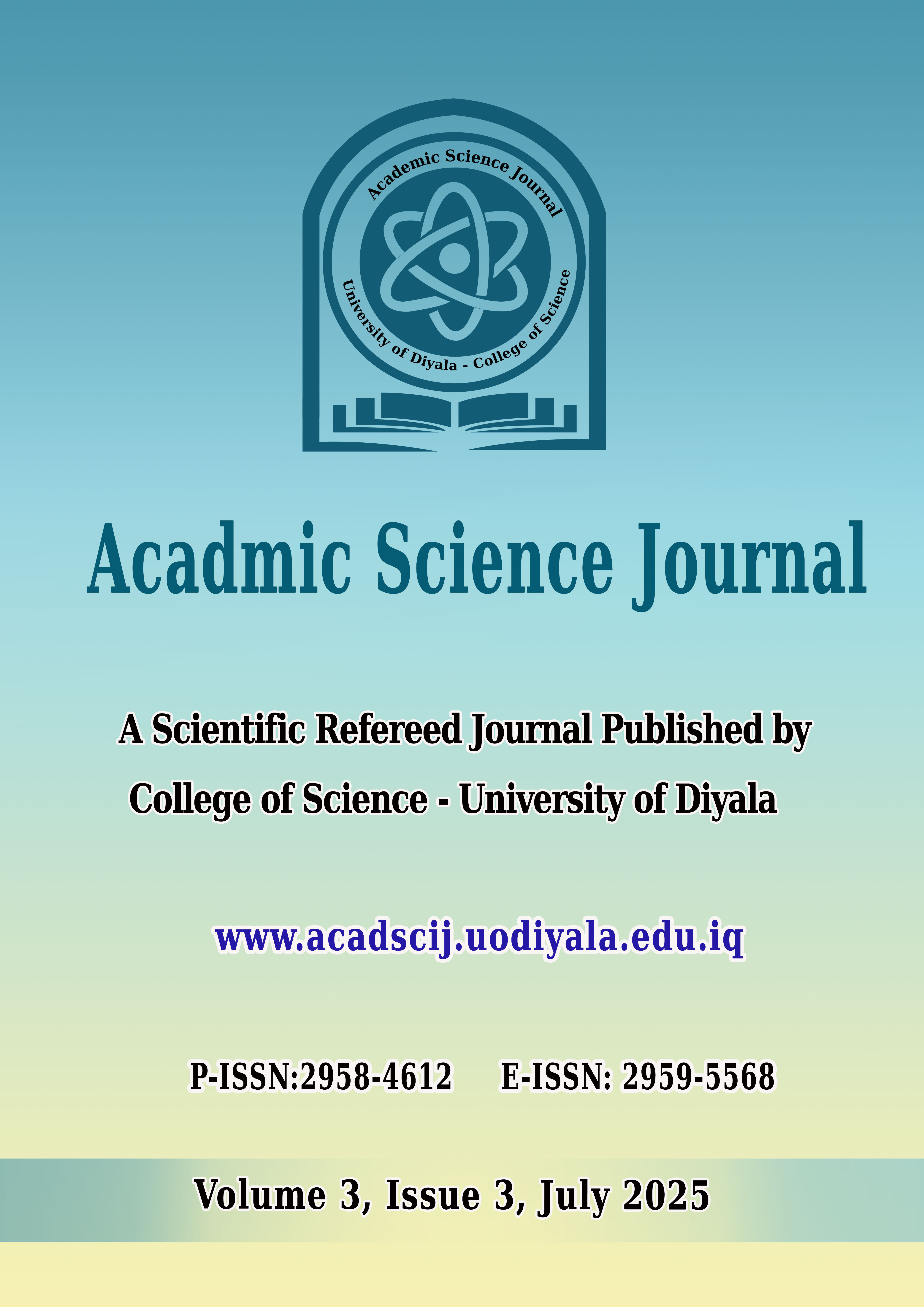The Importance of Biochemical Markersin Diagnosing,Managing and Predicting Diabetes Mellitus
DOI:
https://doi.org/10.24237/ASJ.03.03.962AKeywords:
Gestational diabetes, Insulin resistance , biomarker Analysis, HbA1cAbstract
Diabetes is a widespread and intricate metabolic illness marked by persistent high blood sugar because of flaws in insulin production, insulin activity, or both. Current treatments don't address the disease's complete development, and management often fails because individual traits vary. People may experience either a metabolic pathway becoming inactive or over stimulated, which can lead to different levels of blood sugar control.
Biochemical markers of this condition are very important for early detection, management, and diagnosis because clinical symptoms alone are often not reliable. The focus of treatment should be on results, including supporting mental health care. Diabetes is growing around the world, especially in developing regions where healthcare access is spotty. Therefore, investigating how precision medicine, along with biometrics and biochemical data, can augment existing methods is of value. These sources of data could improve health outcomes and reduce future problems.
Samples were taken from patients from several hospitals in Diyala Governorate: Baquba Teaching Hospital, Al-Zahraa Hospital, and Al-Khalis Hospital. This investigation included 90 patients with various forms of diabetes (T1DM, T2DM, and gestational), aged 25 to 70, with a male to female ratio of 38/52. The distribution of diabetes types was as follows: T2DM (47/90), T1DM (17/90), and gestational diabetes (26/90). Sample collection took place over 10 months.
This investigation sought to examine diabetes cases and the function of biochemical markers (HbA1c, LDL, and triglycerides) along with biometric variables (body weight and BMI) in creating specific treatments. The results showed better blood sugar control and lowered heart issue risk. Treatment plans considering individual biochemistry helped lower blood sugar and reduce body inflammation. Doctors may improve patient care by creating plans based on individual needs, rather than using a standard approach. The findings suggest that personalized medicine can improve the treatment of diabetes patients, reduce side impacts, and improve overall well-being.
Downloads
References
[1] H. B. Felicia, N. E. Adler, S. A. Berkowitz, M. H. Chin, T. L. Gary-Webb, A. Navas-Acien, P. L. Thornton, and D. Haire-Joshu, Social Determinants of Health and Diabetes: A Scientific Review, PubMed Central, 44(1) 258–279(2020), DOI(https://doi.org/10.2337/dci20-0053)
[2] A. Boles, R. Kandimalla and P. H. Reddy, Dynamics of diabetes and obesity: Epidemiological perspective, Biochimica et Biophysica Acta (BBA) - Molecular Basis of Disease, 1863(5), 1026-1036(2017), DOI(https://doi.org/10.1016/j.bbadis.2017.01.016)
[3] A. Antar, N. A. Ashour, M. Sharaky, M. Khattab, N. A. Ashour, R. T. Zaid, E. J. Roh, A. A. Al-Karmalawy and A. Elkamhawy, Diabetes mellitus: Classification, mediators, and complications; A gate to identify potential targets for the development of new effective treatments, Biomedicine & Pharmacotherapy, 168, (2021), DOI(https://doi.org/10.1016/j.biopha.2023.115734)
[4] J. Raffin, P. d. Souto, A. P. Le Traon, B. Vellas, M. A. Leheudre and Y. Rolland, Sedentary behavior and the biological hallmarks of aging, Ageing Research Reviews, 83, (2023), DOI(https://doi.org/10.1016/j.arr.2022.101807)
[5] V. S. S. Nishad, D. Dongare, A. C. Pati Tripathi, T. Tripathi and P. Tripathi, Deciphering the intricacies of immune system dysfunction and its impact on diabetes mellitus: Revisiting the communication strategies to manage diabetes mellitus, Health Sciences Review, 13, (2024), DOI(https://doi.org/10.1016/j.hsr.2024.100201)
[6] X. Cheng, X. Meng, R. Chen, Z. Song, S. Li, S. Wei, H. Lv, S. Zhang, H. Tang, Y. Jiang and R. Zhang, The molecular subtypes of autoimmune diseases, Computational and Structural Biotechnology Journal, 23, 1348-1363(2024), DOI(https://doi.org/10.1016/j.csbj.2024.03.026)
[7] A. A. Choudhury, and V. Devi Rajeswari, Gestational diabetes mellitus - A metabolic and reproductive disorder, Biomedicine & Pharmacotherapy, 143, (2021), DOI(https://doi.org/10.1016/j.biopha.2021.112183)
[8] M. Puccetti, Marilena Pariano, Aurélie Schoubben, Stefano Giovagnoli and Maurizio Ricci, Biologics, theranostics, and personalized medicine in drug delivery systems, Biologics, theranostics, and personalized medicine in drug delivery systems, 201, (2024), DOI(https://doi.org/10.1016/j.phrs.2024.107086)
[9] A. S. Cruz, A. Mendes-Frias, A. I. Oliveira, L. Dias, A. R. Matos, A. Carvalho, C. Capela, J. Pedrosa, A. G. Castro and R. Silvestre, Interleukin-6 Is a Biomarker for the Development of Fatal Severe Acute Respiratory Syndrome Coronavirus 2 Pneumonia, Frontiers in immunology, 12, (2021), DOI(https://doi.org/10.3389/fimmu.2021.613422)
[10] M. Ortiz-Martínez, M. González-González, AJ. Martagón, V. Hlavinka, RC. Willson and M. Rito-Palomares, Recent Developments in Biomarkers for Diagnosis and Screening of Type 2 Diabetes Mellitus, Curr Diab Rep, 22(3), 95-115(2022), DOI(https://doi.org/10.1007/s11892-022-01453-4)
[11] G. E. Grieco, Z. M. Besharat, G.Licata, D. Fignani, N. Brusco, L. Nigi, C. Formichi, A. Po, C. Sabato, A. Dardano, A. Natali, F. Dotta, G. Sebastiani, and E. Ferretti, Circulating microRNAs as clinically useful biomarkers for Type 2 Diabetes Mellitus: miRNomics from bench to bedside, Translational Research, 247, 137-157(2022), DOI(https://doi.org/10.1016/j.trsl.2022.03.008)
[12] M. Jabara, O. Kose, G. Perlman, S. Corcos, and M. Ant, Artificial Intelligence-Based Digital Biomarkers for Type 2 Diabetes: A Review, Canadian Journal of Cardiology, 40(10), 1922-1933(2024), DOI(https://doi.org/10.1016/j.cjca.2024.07.028)
[13] H. Kaur, A.V. Raveendran, S. Athwal, M. Verma, V. Mutreja, K. E. Ukhurebor, and H. S. Kusuma, Assessment of diabetes biomarker monitoring via novel biosensor activity, Results in Chemistry, 5, (2023), DOI(https://doi.org/10.1016/j.rechem.2023.100777)
[14] H. Breiteneder, Y. Q. Peng, I. Agache, Z. Diamant, T. Eiwegger, W. J. Fokkens, C. Traidl-Hoffmann, K. Nadeau, R. E. O'Hehir, L. O'Mahony, O. Pfaar, M. J. Torres, D. Y. Wang, L. Zhang, and C. A. Akdis, Biomarkers for diagnosis and prediction of therapy responses in allergic diseases and asthma, Allergy, 75(12), 3039–3068(2020), DOI(https://doi.org/10.1111/all.14582)
[15] T. Litman, Personalized medicine—concepts, technologies, and applications in inflammatory skin diseases, Acta pathologica microbiologica et immunologica Scandinavica, 127(5), 386-424(2019), DOI(https://doi.org/10.1111/apm.12934)
[16] C. Ciurtin, G. A. Helmy , A. C. Ferreira, J. J. Manson , E. C. Jury, and T. McDonnell, A tale of two functions: C-reactive protein complement-ary structures and, Clinical Immunology, 265(2024), DOI(https://doi.org/10.1016/j.clim.2024.110281)
[17] C. Luna-Marco, F. Iannantuoni, A. Hermo-Argibay, D. Devos, J. D. Salazar, V. M. Víctor, and S. Rovira-Llopis, Cardiovascular benefits of SGLT2 inhibitors and GLP-1 receptor agonists through effects on mitochondrial function and oxidative stress, Free Radical Biology and Medicine, 213, 19-35(2024), DOI(https://doi.org/10.1016/j.freeradbiomed.2024.01.015)
[18] A. Elrakaybi, K. Laubner, Q. Zhou, M. J. Hug, and J. Seufert, Cardiovascular protection by SGLT2 inhibitors – Do anti-inflammatory mechanisms play a role?, 64, (2022), DOI(https://doi.org/10.1016/j.molmet.2022.101549)
[19] H. Chehregosha, M. E. Khamseh, M. Malek, F. Hosseinpanah, and F. Ismail-Beigi, A View Beyond HbA1c: Role of Continuous Glucose Monitoring, Diabetes Therapy, 10, 853–863(2019), DOI(https://doi.org/10.1007/s13300-019-0619-1)
[20] J. Sztabkowska, Milena, B. Głowińska-Olszewska, and A. Bossowski, C-peptide and residual β-cell function in pediatric diabetes–state of the art, Pediatric Endocrinology Diabetes and Metabolism, 27(2), 123-133(2021), DOI(https://doi.org/10.5114/pedm.2021.107165)
[21] E. K. Duran, A. W. Aday, N. R. Cook, J. E. Buring, P. M. Ridker, and A. D. Pradhan, Triglyceride-Rich Lipoprotein Cholesterol, Small Dense LDL Cholesterol, and Incident Cardiovascular Disease, Journal of the American College of Cardiology, 75(17), 2122–2135(2020), DOI(https://doi.org/10.1016/j.jacc.2020.02.059)
[22] C. E. Kosmas, R. Polanco, S. Bousvarou, M. D. Papakonstantinou, E. J. Peña Genao, E. Guzman, C. E. Kostara, The Triglyceride/High-Density Lipoprotein Cholesterol (TG/HDL-C) Ratio as a Risk Marker for Metabolic Syndrome and Cardiovascular Disease, Diagnostics, 13(5), (2023), DOI(https://doi.org/10.3390/diagnostics13050929)
[23] A. Aulanni'am, D. K. Wuragil, H. Susanto, A. Herawati, Y. M. Nugroho, W. N.Laili Fajri, P. F. Putri, S. Susiati, J. D. T. Purnomo, A. Taufiq, and D. W. Soeatmadji, The early detection of type 1 diabetes mellitus and latent autoimmune diabetes in adults (LADA) through rapid test reverse-flow immunochromatography for glutamic acid decarboxylase 65 kDa (GAD65), Heliyon, 8(1), (2022)
[24] G. F. Hassan, and M. J. A. Al-Imari, Anti-Glutamic acid Decarboxylase Autoantibody as Biomarker for Diagnosis of Type 1DM Patients in Iraq, Indian Journal of Public Health Research & Development, 10(2), 778-783(2019)
[25] A. MMI, Role of visfatin in obesity-induced insulin resistance, World journal of clinical cases, 10(30), 10840–10851(2022), DOI(https://doi.org/10.12998/wjcc.v10.i30.10840)
[26] S. A. A. Rabo, N. A. Mohammed, S. S. Eissa, A. A. Ali, S. M. Ismail, and R. S. Gad, Serum visfatin in type 2 diabetes mellitus, Egyptian Journal of Internal Medicine, 27-32(2013), DOI(https://doi.org/10.7123/01.EJIM.0000425961.54125.23)
[27] P. Bjornstad, M. Schäfer, U. Truong, M. Cree-Green, L. Pyle , A. Baumgartner, Y. G. Reyes , A. Maniatis, S. Nayak , R. P. Wadwa, L. P. Browne, J. E. B. Reusch, and K. J. Nadeau, Metformin Improves Insulin Sensitivity and Vascular Health in Youth With Type 1 Diabetes Mellitus: Randomized Controlled Trial, Circulation, 138(25), 2895-2907(2018), DOI(https://doi.org/10.1161/CIRCULATIONAHA.118.035525)
[28] Y. Chen, F. Gu, J. Guan, and Y. Ji, Metformin Might Inhibit Virus through Increasing Insulin Sensitivity, Chinese Medical Journal, 131(3), 376-377(2018), DOI(https://doi.org/10.4103/0366-6999.223856)
[29] M. Guo, J. Gu, F. Teng, J. Chen, X. Ma, Q. Chen, Y. Pu, Z. Jiang, Y. Long, and Y. Xu, The efficacy and safety of combinations of SGLT2 inhibitors and GLP-1 receptor agonists in the treatment of type 2 diabetes or obese adults: a systematic review and meta-analysis, Endocrine, 67, 294–304(2020), DOI(https://doi.org/10.1007/s12020-019-02175-6)
[30] E. Brown, J. P. H. Wilding, T. M. Barber, U. Alam, and D. J. Cuthbertson, Weight loss variability with SGLT2 inhibitors and GLP-1 receptor agonists in type 2 diabetes mellitus and obesity: Mechanistic possibilities, Obesity Reviews, 20(6), 816-828(2019), DOI(https://doi.org/10.1111/obr.12841)
[31] C. F. Deacon, Dipeptidyl peptidase 4 inhibitors in the treatment of type 2 diabetes mellitus, Nature Reviews Endocrinology, 16(11), 642-653(2020), DOI(https://doi.org/10.1038/s41574-020-0399-8)
[32] K. Makrilakis, The role of DPP-4 inhibitors in the treatment algorithm of type 2 diabetes mellitus: when to select, what to expect, International journal of environmental research and public health, 16(15), 2720(2019), DOI(https://doi.org/10.3390/ijerph16152720)
[33] G. A. Nichols, S. Philip, K. Reynolds, C. B. Granowitz, and S. Fazio, Increased Cardiovascular Risk in Hypertriglyceridemic Patients With Statin-Controlled LDL Cholesterol, The Journal of Clinical Endocrinology & Metabolism, 103(8), 3019–3027(2018), DOI(https://doi.org/10.1210/jc.2018-00470)
[34] A. K. Shrivastava, H. V. Singh, A. Raizada, S. K. Singh, A. Pandey, N. Singh, D. S. Yadav, and H. Sharma, Inflammatory markers in patients with rheumatoid arthritis, Allergologia et Immunopathologia, 43(1), 81-87(2015), DOI(https://doi.org/10.1016/j.aller.2013.11.003)
[35] D. M.Giudice, and S. W. Gangestad, Rethinking IL-6 and CRP: Why they are more than inflammatory biomarkers, and why it matters, Brain, behavior, and immunity, 70(1), 61-75(2018), DOI(https://doi.org/10.1016/j.bbi.2018.02.013)
[36] A. S. Alexopoulos, A. Qamar, K. Hutchins, M. J. Crowley, B. C. Batch, and J. R. Guyton, Triglycerides: emerging targets in diabetes care? Review of moderate hypertriglyceridemia in diabetes, Current diabetes reports, 1-11(2019), DOI(https://doi.org/10.1007/s11892-019-1136-3)
[37] T. V. Rohm, D. T. Meier, J. M. Olefsky, and M. Y. Donath, Inflammation in obesity, diabetes, and related disorders, Immunity, 55(1), 31-55(2022)
[38] L. M. Jacobsen, and D. Schatz, Immunotherapy-based strategies for treatment of type 1 diabetes, Hormone Research in Paediatrics, 1-19(2024), DOI(https://doi.org/10.1159/000542002)
Downloads
Published
Issue
Section
License
Copyright (c) 2025 CC BY 4.0

This work is licensed under a Creative Commons Attribution 4.0 International License.











